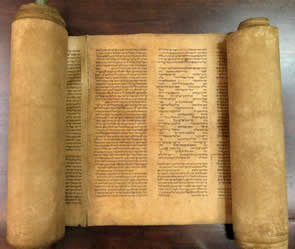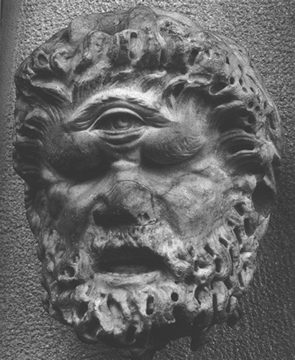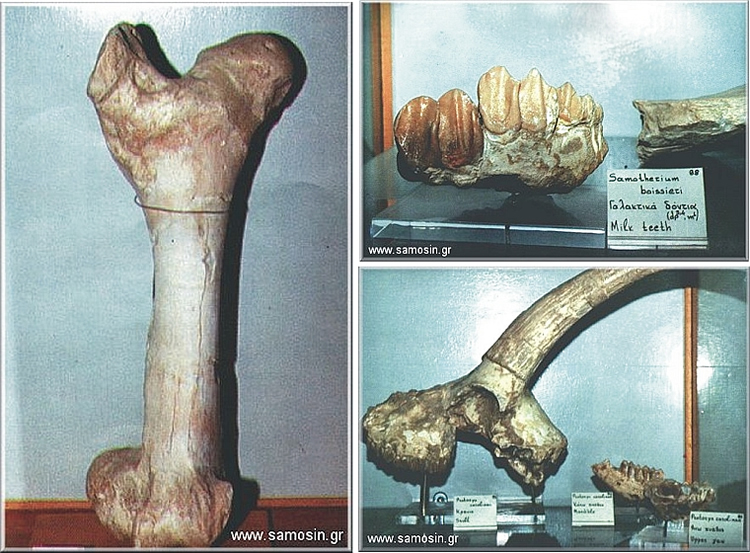-Stage 4.5.1-
DINOSAURS! From Cultural to Pop Culture
"Prehistoric Times"
"Before the 19th century when dinosaur bones turned
up they were taken as evidence of dragons, ogres,
or giant victims of Noah's Flood"
(Updike, 2007)

Biblical Behemoths
The oldest known Torah, the Jewish Holy book (CBS News)
Our first stop along the ride through history is approximately 2,000 BC, which is when it was assumed the Book of Job from the Old Testament was written. That is where we run across the passage:
15 Behold now behemoth, which I made with thee; he eateth grass as an ox.
16 Lo now, his strength is in his loins, and his force is in the navel of his belly.
17 He moveth his tail like a cedar: the sinews of his stones are wrapped together.
18 His bones are as strong pieces of brass; his bones are like bars of iron.
Job 40:15-18
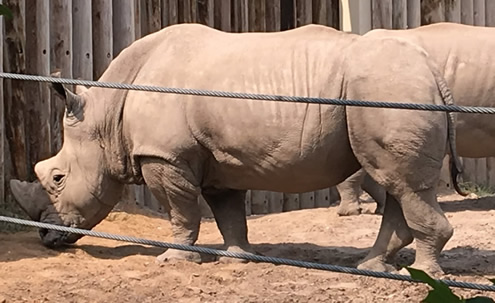
White Rhinoceros from Utah's Hogle Zoo. Photo by Jim Lehane.
The main reason this is our first stop, and not another one a little further along the timeline, is that Creationists seem to have taken up this phrase as proof that dinosaurs were in the Bible and have been around since Creation. If we analyze the passage we do have something that can be described as a dinosaur it seems. First off "behemoth" is a rather obscure term but since the term dinosaur wasn't coined until 1854 this could be taken as a dinosaur, or as any other unknown/obscure animal of the time.

African Elephant from Utah's Hogle Zoo. Photo by Jim Lehane.
Picking apart other parts of the passage we have "he eateth grass as an ox", indicating an herbivore. The next line, "his strength is in his loins, and his force is in the navel of his belly". I'm not really sure how to interpret that one, but we will just assume it means the animal is pretty big and strong, not really a physical description though. Now we get to the line that is the primary "proof" given for it being a dinosaur; "tail like a cedar". Not many, if any,animals today contain a tail that can be described as "like a cedar".Looking at the next line, "bones are as strong pieces of brass; his bones are like bars of iron", we get the feeling of a large animal with large bones and large limbs. But all modern day large animals with large limbs, all contain tiny little tails (like the elephant and the rhino).
This has been one of the the "proofs" that Creationists provide as evidence that dinosaurs were in the Bible, since no modern day animal can fit the mold. Dinosaurs do seem to fit it well though. So does this mean dinosaurs really did live with mankind? I don't think so, but I think this is an important entry in the Dinosaurs! From Cultural to Pop Culture series, and one that couldn't be forgotten.
References
Updike, John. 2007. Extreme Dinosaurs. National Geographic Magazine. V. 212, N. 6, pp 32-57
Bible references obtained from the King James Version: http://kingjbible.com/job/40.htm
https://www.cbsnews.com/news/expert-discovers-ancient-torah-scroll-in-plain-sight/
The Cyclops
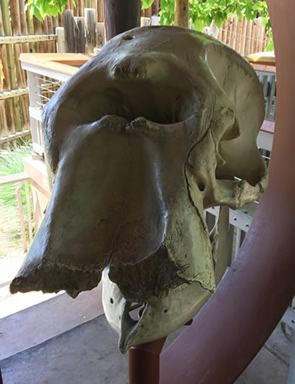
Young male African Elephant Skull replica at Utah's Hogle Zoo. Picture by Jim Lehane.
Sculpture of the cyclops Polyphemus (List of Figures)
The next stop along our travels through time is not a dinosaur stop but an important one none-the-less. I placed it at ~800 BC because that is the estimated date that Homer wrote the Odyssey. In the Odyssey, Odysseus is making his way back home and along the way lands on the Island of the Cyclops, where he meets Polyphemus (figured right). Homer then goes on to describe the cyclops, which is usually what we would assume a cyclops to look like; typically very large and have one eye located in the center of their forehead. This is not the first historical encounter with a cyclops in Greek history, but this is just the first substantial reference to one that has survived to the modern day.
Looking at the geology of Greece, they are not known for large dinosaur deposits but what they do have is large amounts of Pleistocene deposits. The Pleistocene deposits are rich in that are rich in prehistoric elephant fossils. In particular, the ancient, dwarf elephants. The skulls of the dwarf elephants are on average, twice the size of a human skull and posses a large hole in the center of the "forehead". Modern humans now know this is for the nasal passage of the trunk, but the ancient Greeks, who have had no contact with elephants before, likely assumed that it to be a lone eye socket (pictured left). This was all interpreted by a paleobiologists by the name of Othenio Abel in 1914, and it makes sense (Mythicalcreaturesguide.com). The ancient Greeks discovered the overly-large "human-like" skulls with the singular eye socket and assumed they belonged to a race of massive, one-eyed giants.
References
https://listoffigures.wordpress.com/2010/04/
http://www.mythicalcreaturesguide.com/page/Cyclops#fbid=b0vGB_AGot9
The Griffin
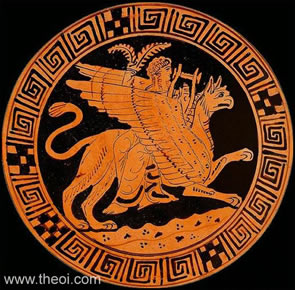
Apollo riding a griffin circa 380 BC (theoi.com).
Continuing along through Greek mythology we have the griffin. The griffin is a combination eagle head with a lion's body. I picked ~400 BC as the date for this stop because this is when the famous tale of Prometheus Bound was likely written by Aeschyles. In the story Prometheus is bound to a rock as torture for giving fire to humanity. While he is tied to this rock he is force to endure griffins repeatedly eating out his liver. Then, when they are done, the liver is allowed to grow back again, starting whole process over again. This isn't the first occurrence of griffins in history but it is one of the most prominent early examples so I figured this would be a good place to mark it. Within mythology, one of the principle traits of the griffin, other than its ability to fly, is that it is often found guarding treasure.
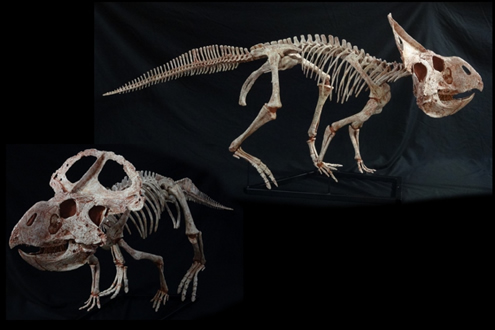
Protoceratops replica from Gaston Designs.
One theory for the origin of the griffin is that the Greeks were trading with a group of people called the Scythian Nomads. The trade routes of these nomads traveled from Mongolia and down into Greece where they traded gold, among other things. The source location for their gold was likely at the base of some cliffs near the Gobi Desert. The gold would have likely eroded out of the Altai Mountains in Mongolia and settled on the fringes of the desert. Along side the gold deposits the traders found these bizarre looking skeletons, unlike what they have ever seen before. When coming across such things most people try to relate it to what they know. They recognized the beak, like that of a bird, and the bird-like-talons, but the size and shape of the body didn't make sense. This must be a beast that is a combination of a bird and something else, possibly a lion. We now know that the skeleton was that of a Protoceratops. The only question that now remained is what happened to the frill of the dinosaur in the nomads reconstruction? It is likely that if the frill was broken into pieces, the placement of the frill along the back could give evidence for the presence of wings. Once discovering these and creating the griffin myth, the nomads then transported this tale all over Europe during their travels (Mayor, 2000; Ancient Monster Hunters; Wikipedia).
References
https://www.theoi.com/Gallery/K5.7.html
https://www.gastondesign.com/our-products/dinosaur-skeletons/
http://www.youtube.com/watch?v=I6VLojsbAIQ
http://en.wikipedia.org/wiki/Protoceratops#Origin_of_griffin_myths
Mayor, Adrienne. 2000. The First Fossil Hunters: Paleontology in Greek and Roman Times. Princeton University Press, Princeton, NJ
The Neades
Samos is a Greek island located in the Aegean Sea, near present day Turkey:
This island has been written about numerous times in the ancient past. One of the notable examples was the following:
"...in primeval times Samos was uninhabited [except for] animals of gigantic size, which were savage and dangerous, called Neades. Now these animals with their mere roaring split the ground. So there is a proverbial saying in Samos: 'So and so roars louder than the Neades.' And Euphorion asserts that their huge remains are displayed even to this day"
Euphorion (~220 BC)
Quoted in On Animals by Aelian (3rd Century AD)
The Neades seem to be similar to other ancient beasts, which were the works of ancient authors finding the fossils and trying to come up with a story to explain them. Below are some of the fossils that have been found on the island of Samos and have been dated to the Tourolio during the Early Miocene (samosin.gr).
The original writings of Euphorion had been lost, but the above section had been quoted by the natural historian Aelian in the 3rd century AD. Fossils today have been found in the Mytilini basin, which is located north of the village of Mytilini on Samos, along a major fault zone on Samos. Faults = earthquakes. Perhaps the ancient Greeks equated the earthquakes with the roar of the Neades (Soulinias, 2007). Euphorion's quote also seems to focus on the fossils being put on display. It was discovered that around the 7th century BC a large fossil thighbone was placed on an altar of the Temple of Hera, a popular place at the time (Kyrieleis, 1988). It is likely that Euphorion saw the thighbone and created a tale of his own to explain it. Besides Euphorion's tale, not much is written about the Neades (I couldn't even find an illustration depicting them), but Samos continued to be a focal point where paleontology influenced the culture of the time period. For the next stop we will look at when Plutarch made a more impactful statement about where he thinks the fossils came from.
References
Kyrieleis, H. (1988). Offerings of the common man in the Heraion at Samos. Early Greek cult practice, 215-21.
Mayor, Adrienne. 2000. The First Fossil Hunters: Paleontology in Greek and Roman Times. Princeton University Press, Princeton, NJ
http://www.youtube.com/watch?v=I6VLojsbAIQ
http://www.theoi.com/Thaumasios/Neades.html
http://www.samosin.gr/item/natural-history-museum-of-the-aegean/
Battle of the Amazonians
For our next entry, we continue on the island of Samos with the last entry in the "Prehistoric Times" (at least for now).
A long time after Euphorion talked about the Neades (about 300 years), Plutarch came and also came up with a reason for the bones on the island. Plutarch talked about a tale where the god Dionysus tried to recruit the giant Amazon warriors, however they refused, and Dionysus pursued them to Samos. A great battle took place and the Amazonians were slaughtered in "fields of blood".
The majority of Samos is covered with white and beige sediments and rocks, however there is a significant deposit of red sediments with many white fossil bones eroding out of them. The localities of these deposits coincide with the locations of battles depicted on ancient maps.
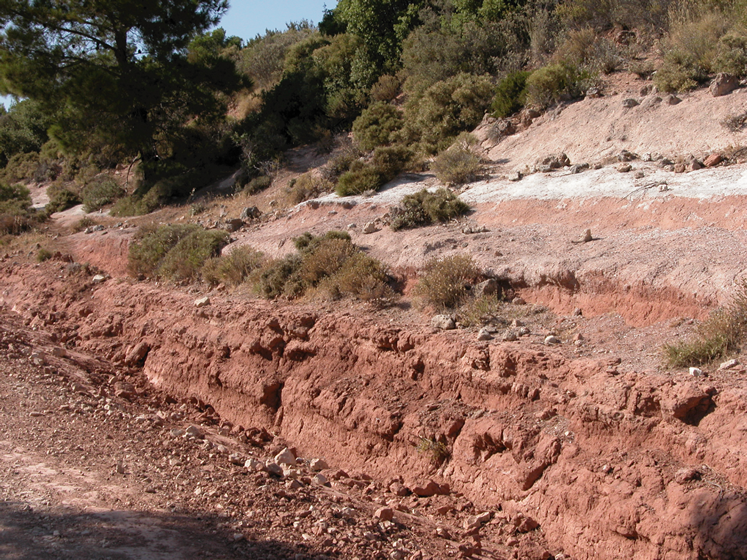
Samos red rock fossil beds (Soulinias, 2007)
The deposits of these fossils were found within a volcanic tuffa that was interbedded with sandy marls and gravels from the Early Miocene. The variety of mammals within the fossil beds is astounding, ranging from Mastodons, rhinos, and hyenas, to flightless birds (Forsyth Major, 1893).
One of the most common fossils that are found on the island is that of the Prehistoric horse, Hippotherium. Coincidently (or perhaps not), the Amazonian's were known to have rode horses into battle.
Fossil of Hippotherium gracile (By Ghedoghedo - Own work, CC BY-SA 3.0, https://commons.wikimedia.org/w/index.php?curid=11329565)
References
Mayor, Adrienne. 2000. The First Fossil Hunters: Paleontology in Greek and Roman Times. Princeton University Press, Princeton, NJ
http://www.youtube.com/watch?v=I6VLojsbAIQ
https://en.wikipedia.org/wiki/Hippotherium
https://commons.wikimedia.org/w/index.php?curid=11329565
https://books.google.com/books?id=KEdSAQAAMAAJ
The Prehistoric Age is separated from the Medieval Age by the presence of one thing, dragons. Dragons have been around for thousands of years, but mostly in Eastern cultures such as ancient China. In the next section we take a look at how dragon representation has evolved through time and we briefly discuss how they could possibly stem from dinosaur bones. And now on to the...

